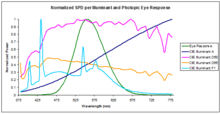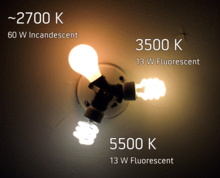Spectral power distribution

In
Knowledge of the SPD is crucial for optical-sensor system applications.
Physics
Mathematically, for the spectral power distribution of a radiant exitance or irradiance one may write:
where M(λ) is the
Relative SPD
The ratio of spectral concentration (irradiance or exitance) at a given wavelength to the concentration of a reference wavelength provides the relative SPD.[4] This can be written as:
For instance, the
Responsivity
The SPD can be used to determine the response of a sensor at a specified wavelength. This compares the output power of the sensor to the input power as a function of wavelength.[7] This can be generalized in the following formula:
Knowing the responsitivity is beneficial for determination of illumination, interactive material components, and optical components to optimize performance of a system's design.
Source SPD and matter

The spectral power distribution over the visible spectrum from a source can have varying concentrations of relative SPDs. The interactions between light and matter affect the absorption and reflectance properties of materials and subsequently produces a color that varies with source illumination.[8]
For example, the relative spectral power distribution of the sun produces a white appearance if observed directly, but when the sunlight illuminates the Earth's atmosphere the sky appears blue under normal daylight conditions. This stems from the optical phenomenon called Rayleigh scattering which produces a concentration of shorter wavelengths and hence the blue color appearance.[3]
Source SPD and color appearance

The human visual response relies on trichromacy to process color appearance. While the human visual response integrates over all wavelengths, the relative spectral power distribution will provide color appearance modeling information as the concentration of wavelength band(s) will become the primary contributors to the perceived color.[8]
This becomes useful in photometry and colorimetry as the perceived color changes with source illumination and spectral distribution and coincides with metamerisms where an object's color appearance changes.[8]
The spectral makeup of the source can also coincide with color temperature producing differences in color appearance due to the source's temperature.[4]
See also
References
- ISBN 0-470-01216-1.
- ^ ISBN 978-0-240-80740-9.
- ^ ISBN 0890066787.
- ^ ISBN 0123049016.
- ISBN 0029488001.
- ISBN 978-0-471-39918-6.
- ISBN 047186188X.
- ^ a b c William David Wright (1969). The Measurement of Colour. New York: Van Nostrand Reinhold Co.
External links
- Spectral Power Distribution Curves, GE Lighting.




